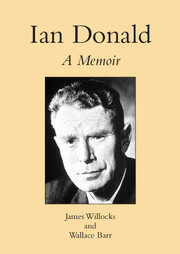Book contents
- Frontmatter
- Contents
- Illustrations
- Acknowledgments
- Miscellaneous Frontmatter
- Preface
- 1 Early life and training
- 2 London 1946—54
- 3 Appointment to the Glasgow Chair
- 4 Glasgow obstetrics in the Fifties
- 4 Sharing Enthusiasm: A textbook – and a teacher – with a difference
- 5 The Western Infirmary Wards G9 and 10
- 6 The cutting edge – in the operating theatre
- 7 The Queen Mother's Hospital
- 8 Science and Serendipity: Ultrasound takes off
- 9 Home life and hobbies
- 10 “Naught for your comfort”: social reform and medical ethics in a changing world
- 11 “At the receiving end”: courage and faith
- 12 “The evening cometh”: international fame, continued battle with illness and home happiness in retirement
- Sources
- Index
- Plate section
2 - London 1946—54
Published online by Cambridge University Press: 05 February 2014
- Frontmatter
- Contents
- Illustrations
- Acknowledgments
- Miscellaneous Frontmatter
- Preface
- 1 Early life and training
- 2 London 1946—54
- 3 Appointment to the Glasgow Chair
- 4 Glasgow obstetrics in the Fifties
- 4 Sharing Enthusiasm: A textbook – and a teacher – with a difference
- 5 The Western Infirmary Wards G9 and 10
- 6 The cutting edge – in the operating theatre
- 7 The Queen Mother's Hospital
- 8 Science and Serendipity: Ultrasound takes off
- 9 Home life and hobbies
- 10 “Naught for your comfort”: social reform and medical ethics in a changing world
- 11 “At the receiving end”: courage and faith
- 12 “The evening cometh”: international fame, continued battle with illness and home happiness in retirement
- Sources
- Index
- Plate section
Summary
In 1946 Ian was able to come back from his war service to his beloved St Thomas' Hospital, one of the most prestigious of London's historic teaching hospitals.
St Thomas' (named after Thomas à Becket) was founded in the twelfth century. In the early fifteenth century, Lord Mayor Richard Whittington (of “turn again” fame) made “a new chamber of eight beds for young women who had done amiss, in trust of a good amendment”. In 1535 it was called by a government official “the bawdy hospital of St Thomas in Southwark”, not because of young lady patients but because the master kept a concubine and had sold the church plate. In 1561 unmarried pregnant women were refused admission because the hospital was erected for the relief “of honest persons and not of harlottes”. In the virtuous Victorian era, the hospital had emerged from its chequered past and a vast new edifice was built in 1871 on a block principle that was approved by Florence Nightingale, who established in it the Nightingale School of Nursing and thus revolutionised the nursing profession. From then on, St Thomas' nurses were known as “Nightingales”. The medical school also opened in 1871.
St Thomas' and its associated Lambeth Hospital and the Chelsea Hospital for Women were busy centres for obstetrics and gynaecology and that was the specialty that Ian chose to follow on his return from the RAF.
- Type
- Chapter
- Information
- Ian DonaldA Memoir, pp. 3 - 10Publisher: Cambridge University PressPrint publication year: 2004

